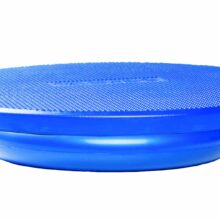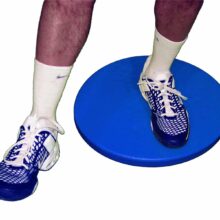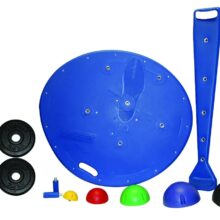Rocker Board – Wooden with Carpet
Se connecter pour obtenir les prix des revendeurs
The CanDo® Rocker Board – Wooden with Carpet can be purchased in any of 3 different sizes and has a non slip “carpet” surface for added safety.
The CanDo® Rocker Board – Wooden with Carpet is a balance improvement exercise tool. You can use it to simulate a rocking motion that will help improve balance control and your patient’s vestibular responses. It can also be used for rehabilitation and range of motion improvement when recovering from ankle and foot injuries like a sprained ankle.
For improved patient safety, the Board is covered with non-slip surface.
It comes in various sizes:
- The Oversize 30 x 60 x 12 inch rocker board moves either side-to-side or front-to-back. Rocking on the board will stimulate balance control and vestibular responses.
- The Deluxe oversize 30 x 60 x 12 inch rocker board moves both side-to-side and front-to-back.
- The Standard size 18 x 18 x 5 inch rocker board also moves both side-to-side and front-to-back to help improve balance control.
A rocker board is a specialized piece of equipment consisting of a flat, rectangular platform mounted on a curved base, resembling the shape of a rocking chair. It is commonly used in fitness, rehabilitation, and sports training settings to improve balance, stability, coordination, and core strength. Here are the key uses and benefits of a these boards:
Uses
- Balance Training: One of the primary uses of a rocker board is to challenge and improve balance. The unstable nature of the board requires users to engage their core muscles and activate stabilizing muscles throughout the body to maintain equilibrium.
- Proprioception Enhancement: The boards are effective tools for enhancing proprioception, which is the body’s ability to sense its position in space. Regular use of the board helps individuals develop a better sense of body awareness and control, which is essential for sports performance and injury prevention.
- Rehabilitation: Rocker boards are frequently used in physical therapy and rehabilitation programs to help patients recover from lower limb injuries, such as ankle sprains or knee surgeries. By gradually progressing from static to dynamic exercises on the board, patients can improve joint stability, range of motion, and functional movement patterns.
- Ankle Strengthening: These boards are particularly beneficial for strengthening the muscles around the ankles, including the stabilizing muscles of the lower leg. Performing exercises such as ankle circles, dorsiflexion, and plantar flexion on the board helps improve ankle strength, mobility, and proprioception.
- Core Stability: Using a rocker board engages the core muscles to maintain balance and stability. Incorporating dynamic movements such as squats, lunges, or rotations challenges the core even further, making it an effective tool for core strengthening exercises.
- Sports Training: Athletes in sports that require agility, balance, and quick changes in direction, such as skiing, snowboarding, surfing, and skateboarding, can benefit from incorporating rocker board exercises into their training routines. The board helps athletes develop the neuromuscular control and balance necessary for optimal performance in their respective sports.
Benefits
- Improved Balance and Stability: Regular use of these boards helps improve overall balance and stability by challenging the body’s ability to maintain equilibrium on an unstable surface. This translates to better coordination and reduced risk of falls or injuries.
- Enhanced Core Strength: Using a board requires constant engagement of the core muscles to stabilize the body. Over time, this leads to increased core strength, which is essential for maintaining proper posture, preventing back pain, and supporting functional movement patterns.
- Injury Prevention: Strengthening the muscles around the ankles, knees, and hips with rocker board exercises can help reduce the risk of lower limb injuries, such as ankle sprains or ACL tears, by improving joint stability and proprioception.
- Increased Range of Motion: Performing dynamic movements on a rocker board, such as squats or lunges, can help improve joint mobility and flexibility in the ankles, knees, and hips, leading to better overall movement mechanics and reduced stiffness.
- Versatility: These boards can be used by individuals of all ages and fitness levels, from beginners to elite athletes, making them a versatile tool for improving balance, stability, and core strength in a variety of settings.
In summary, rocker boards offer a wide range of uses and benefits, including balance training, rehabilitation, core strengthening, injury prevention, and sports performance enhancement. Incorporating rocker board exercises into a fitness routine can lead to improved balance, stability, coordination, and overall functional fitness.






Commentaires
Il n'y a pas encore de commentaires